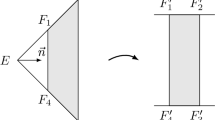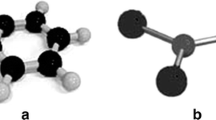Abstract
Problems related to the operator form of the generalized canonical momenta in quantum mechanics are resolved by use of the general quantum mechanical canonical point transformation method. This method can be applied to any general canonical point transformation irrespective of the relationship between the domains of the original and transformed variables. The differential representation of the original canonical momenta pi in the original coordinate space is −i \(\begin{array}{*{20}c} / \\ h \\ \end{array}\) ∂/∂x i and of the transformed canonical momentap i ′ in the transformed coordinate space is −i \(\begin{array}{*{20}c} / \\ h \\ \end{array}\) ∂/∂x i ′. Relationships are derived between the eigenvalues of the original and transformed momenta in either space. The ordering problem for general point transformations is discussed and is shown to be solved. As an example of the generality of the method, it is demonstrated on the point transformation in three dimensions from Cartesian rectilinear to spherical rectilinear coordinates.
Similar content being viewed by others
References
E. Merzbacher,Quantum Mechanics (Wiley, New York, 1961), Chap. 15, Sec. 4.
P. A. M. Dirac,The Principles of Quantum Mechanics (Oxford Univ. Press, London, 1958), Chap. 4, Sec. 26.
D. I. Blokhintsev,Quantum Mechanics (D. Reidel, Dordrecht, Holland, 1964), p. 517.
K. Simon,Am. J. Phys. 33, 60 (1965).
G. R. Gruber,Found. Phys. 1, 227 (1971).
G. R. Gruber,Int. J. Theoret. Phys. 6, 31 (1972).
G. R. Gruber,Am. J. Phys. 40, 1537 (1972).
G. R. Gruber,Int. J. Theoret. Phys. 7, 253 (1973).
R. W. Finkel,Found. Phys. 3, 101 (1973).
B. V. Landau,Found. Phys. 3, 499 (1973).
G. R. Gruber,Found. Phys. 4, 19 (1974).
E. Schrödinger,Ann. d. Physik 79, 745 (1926).
W. Pauli,Z. Physik 36, 336 (1926).
P. A. M. Dirac,Proc. Roy. Soc. A110, 561 (1926).
P. Jordan,Z. Physik 37, 383 (1926).
C. Eckart,Phys. Rev. 28, 711 (1926).
P. S. Epstein,Proc. Nat. Acad. Sci. 12, 634 (1926).
P. Jordan,Z. Physik 38, 513 (1926).
P. A. M. Dirac,Proc. Roy. Soc. A113, 621 (1927).
B. Podolsky,Phys. Rev. 32, 812 (1928).
A. Landé,Principles of Quantum Mechanics (Cambridge Univ. Press, London, 1937), Secs. 50, 51, 58–63.
B. S. DeWitt,Phys. Rev. 85, 653 (1952).
W. Pauli, “Die Allgemeinen Prinzipien der Wellenmechanik,” inHandbuch der Physik (Springer-Verlag, Berlin, 1956), Band 5, Ziff. 5.
B. S. DeWitt,Rev. Mod. Phys. 29, 377 (1957).
L. D. Dureau,Am. J. Phys. 33, 895 (1965).
G. Rosen,Formulation of Classical and Quantum Dynamical Theory (Academic Press, New York, 1969), Chap. 2.
F. M. Eger and E. P. Gross,Ann. Phys. (N. Y.) 24, 63 (1963).
F. M. Eger and E. P. Gross,Nuovo Cimento 34, 1225 (1964).
F. M. Eger and E. P. Gross,J. Math. Phys. 6, 891 (1965);7, 578 (1966).
D. Bohm and B. Salt,Rev. Mod. Phys. 39, 894 (1967).
M. J. Cooper,J. Math. Phys. 9, 571 (1968).
E. P. Gross, “Transformation Theory,” inMathematical Methods in Solid State and Superfluid Theory, ed. by R. C. Clark and G. H. Derrick (Plenum Press, New York, 1968).
E. P. Gross,Ann. Phys. (N. Y.) 52, 383 (1969).
N. M. Witriol,J. Math. Phys. 11, 669 (1970).
N. M. Witriol,Phys. Rev. A 1, 1775 (1970).
N. M. Witriol,J. Math. Phys. 12, 177 (1971);12, 2467 (1971).
E. P. Gross,Ann. Phys. (N.Y.) 62, 320 (1971).
S. B. Trickey, N. M. Witriol, and G. L. Morley,Solid State Comm. 11, 139 (1972).
N. M. Witriol,Int. J. Quant. Chem. VIS, 145 (1972).
S. B. Trickey, N. M. Witriol, and G. L. Morley,Phys. Rev. A 7, 1662 (1973).
P. O. Löwdin, inProc. Nikko Symposium on Molecular Physics (Maruzen, Tokyo, 1954), p. 116; G. G. Hall,Proc. Phys. Soc. (Lond.) 75, 575 (1960); J. O. Hirschfelder,J. Chem. Phys. 33, 1462 (1960); S. T. Epstein and J. O. Hirschfelder,Phys. Rev. 123, 1495 (1961); J. O. Hirschfelder and C. A. Coulson,J. Chem. Phys. 36, 941 (1961); J. H. Epstein and S. T. Epstein,Am. J. Phys. 30, 266 (1962); P. D. Robinson and J. O. Hirschfelder,Phys. Rev. 129, 1391 (1963); S. T. Epstein and P. D. Robinson,Phys. Rev. 129, 1396 (1963).
H. Goldstein,Classical Mechanics (Addison-Wesley, Reading, Massachusetts, 1959), Chap. 8.
Author information
Authors and Affiliations
Rights and permissions
About this article
Cite this article
Witriol, N.M. General quantum mechanical canonical point transformations. Found Phys 5, 591–605 (1975). https://doi.org/10.1007/BF00708431
Received:
Issue Date:
DOI: https://doi.org/10.1007/BF00708431




